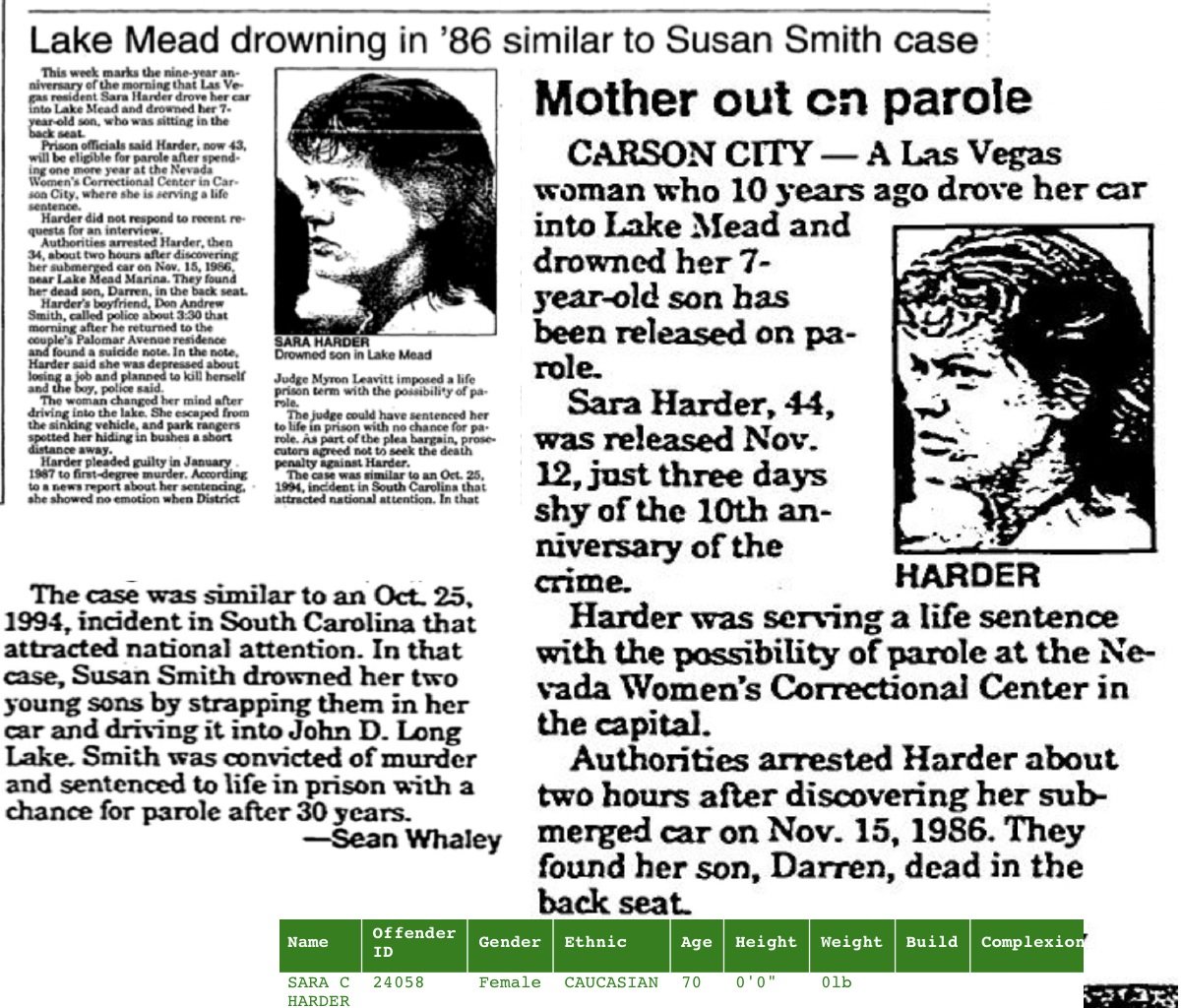A Forgotten Murder at Lake Mead
In November of 1986, Las Vegas resident Sara Catherine Harder committed an unthinkable crime at Lake Mead. (Las Vegas-Clark County Library District/LVRJ)
The discovery of a body in a barrel at Lake Mead in May of this year drew international attention to the nation’s largest reservoir. But the unfortunate victim in the barrel was far from the first brutal murder to occur at Lake Mead.
News outlets across the world turned their focus to Lake Mead after the discovery of a murder victim enclosed in a barrel at the nation’s largest reservoir in May of this year. (BBC/NBC News/NY Times/NY Post)
the torment of sara harder
It was the early morning hours of November 15, 1986, and 34-year-old Sara Catherine Harder was in the grip of a deep depression. Harder had only moved to Las Vegas four years prior with her young son, Darren. During that time, she had settled into her job and struck up a relationship with Don Andrew Smith, who had eventually moved into Harder’s house. But on this night, the recent loss of her job was sending Harder into a dark place where the most unthinkable thoughts were becoming sensible.
As Sara Harder sat contemplating her plight, she found her thoughts steadily turning toward a permanent solution to her problems. It was becoming clearer in Harder’s mind that her financial woes would prevent her from having the type of life she had imagined for herself and her 7-year-old boy. Deciding what must be done, she penned a note and left it in a place where her live-in boyfriend would be sure to find it. Then the young woman woke up her son and told him they were going for a drive.
Harder left her home located a few miles east of downtown Las Vegas at 3905 Palomar Avenue and made the half-hour drive out to Lake Mead Marina. The cold that night was biting as the temperature hovered around a crisp 47 degrees.
After finding a secluded cove near the Marina, Harder brought her car to a stop. She could see the nearly full moon above reflected on the black surface of Lake Mead as she steeled herself for what she was about to do. Then Harder took her foot off the brake as she let the car inch forward until it slipped into the dark water of the lake.
Sara Harder had been ready to meet her end. But the certainty that murder-suicide was the only way out of her problems evaporated as the piercingly cold water began to penetrate the interior of her vehicle, giving way to a panicked desire for survival. Harder forced the driver’s side door open and made her escape from the car as it continued to be consumed by the frigid water. She made her way to the shore and watched as the vehicle submerged entirely, knowing that her son was still helpless in the backseat.
Sara Catherine Harder murdered her 7-year-old son Darren along the shores of Lake Mead not far from the Marina.
tragic discovery
Sometime around 3:30 a.m. that morning, Don Smith – Harder’s boyfriend – discovered the note she had left before making her drive to Lake Mead. Harder expressed in the note that she was severely depressed over the loss of her job and intended to kill herself along with her son. Smith immediately contacted the police, and Harder was reported as a missing person.
Dawn broke without any sign of Sara Harder or her son. At about 10:00 a.m., police scouring Lake Mead spotted something in the water near the Marina. It was Harder’s vehicle. Divers were dispatched, and the car was hauled from the lake to be taken to a nearby parking lot for inspection. It was there that officers discovered Darren’s lifeless body in the backseat.
The search for Harder had turned from a missing persons case to a homicide investigation. Local law enforcement around the Las Vegas area were now on the hunt for the potentially still-suicidal mother, including two rangers with the National Park Service at Lake Mead that were patrolling the shoreline in a boat. At around 12:15 p.m., the two rangers spotted some movement in the brush not far from where the car containing Darren’s body was located. As the rangers approached, they were confronted with a haggard Sara Harder. The murder suspect was arrested and brought to the Clark County Detention Center in downtown Las Vegas.
Sara Harder’s crime appears to fall into the category of “altruistic” maternal filicides. (NIH)
what possible motive…
Research shows that there are five identified motives behind maternal filicides: (1) altruistic; (2) psychotic episode; (3) fatal maltreatment; (4) unwanted child; and (5) revenge against the other parent.
Sara Harder’s murder of her young son Darren has the hallmarks of an altruistic murder, motivated by an often-times suicidal mother’s belief that it would be cruel to leave their child without a parent. There is no information available that explains how long Harder planned her crime, but research indicates maternal filicides motivated by altruism are often planned days to weeks in advance.
Another interesting aspect of the application of available research to Harder’s crime is that depression is frequently a major factor in maternal filicides based on altruistic motives. Harder’s suicide note and subsequent confession to police made it clear that she was in a depressive episode when she drove Darren out to Lake Mead.
Sara Harder’s case did not receive any apparent coverage outside of the local Las Vegas news outlets. Even then, local news outlets provided only minimal coverage of the crime. (Las Vegas-Clark County Library District/LVRJ)
guilt and mercy
Sara Harder was held on $2 million bail per the order of Las Vegas Justice of the Peace Joe Bonaventure, who would later gain national notoriety as the judge that presided over the Ted Binion murder trial.
In January of 1987, Harder appeared before District Court Judge Myron Leavitt. With tears streaming down her face, Harder pled guilty to drowning her son at Lake Mead. Prosecutors had announced their intent to seek the death penalty, and Harder explicitly said she was motivated to plead guilty in part by a desire to avoid the gas chamber. Harder was convicted of first-degree murder, but Judge Leavitt took mercy on her and handed out a sentence of life in prison with the possibility of parole.
Sara Harder was released on parole after serving almost 10 years in prison. Local news covering Harder’s parole noted similarities between her case and the more recent one of Susan Smith, a young mother that murdered her two children by drowning them in a South Carolina lake in 1994. Unlike Harder’s case, Smith’s crime was covered across the country. (Las Vegas-Clark County Library District/LVRJ/NVDOC)
second chances and similatities to susan smith
On November 12, 1996, Sara Harder was released on parole just a few days shy of the 10th anniversary of the murder of her son.
The articles in the local Las Vegas press covering Harder’s parole hearing and release from prison made note of the similarities between Harder and another infamous case involving a mother drowning her children. On October 25, 1994, Susan Smith drove her car into a lake in South Carolina with her two young sons in the backseat. Both children drowned and Smith was sentenced to life in prison.
Unlike the Susan Smith case, which garnered national media attention, Sara Harder’s murder of her son appears to have only been covered by the local Las Vegas press. After Harder’s 1996 release, the Las Vegas-Review Journal contacted her for an interview. Harder declined.






